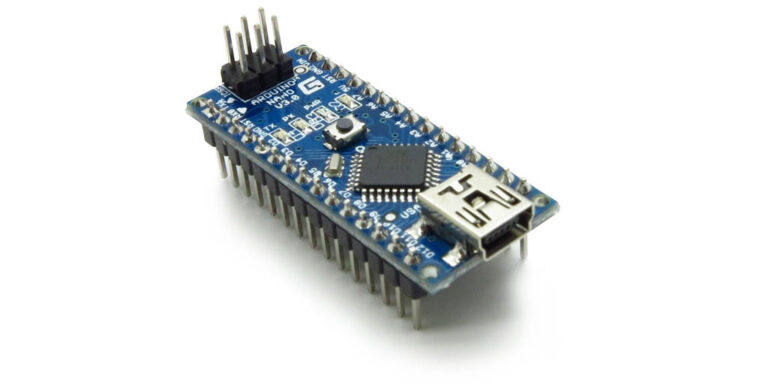The Arduino Nano is a small, popular, microcontroller development board. It is a breakout board for ATmega microcontrollers. The boards are readily available, cheap, breadboard-friendly and easy to work with.
Table of contents
Introduction to the Arduino Nano
The Arduino Nano is a small, popular, microcontroller development board. It is a breakout board for ATmega microcontrollers. The boards are readily available, cheap, breadboard-friendly and easy to work with.

The Arduino Nano has 14 digital pins, 8 analogue pins & is about 45mm long, 18mm wide and 20mm high.
- Get the Arduino Nano from Amazon.com or BangGood
- Get the Arduino Nano With Cable from Amazon.com or BangGood
- Get the Microelectronics Starter Kit from Amazon.com or BangGood
Input and output power
Power can either be supplied with a Mini-B USB cable or via the power (Vin) and ground (GND) pins. The recommended power input range is 7 ~ 12V DC. Each I/O pin will supply 5V DC and 40 mA with a maximum total of 200 mA. This means that within projects, the Arduino Nano will consume very small amounts of current – 3.2 mA (rest) ~ 280 mA (loaded) (< 0.1 – < 2 Watts).
Other features
With its 14 digital I/O pins, of which 6 provide PWM output, and 8 analogue input pins, the Arduino Nanocan be used as a development board, but is also cheap and small enough (45 mm long, 18 mm wide and about 20 mm high) to use directly in projects.
Like other Arduinos, the Nano has a power on and programmable onboard LEDs. The onboard LED can be programmed through pin 13 (high = on, and vice versa). It also has a reset button and pin.
Arduino Nano specifications
There are currently two versions available. Version 2.x has a ATmega168 and version 3.x an ATmega328 micorcontroller. The main difference between the newer and older version is that version 3.x has double the memory (RAM and ROM) (2 Kb vs. 1 kb) and programming space (1 Kb vs. 512 bytes).
Chip: ATmega168 / ATmega328
Number of cores: 1
Architecture: 8-bit
CPU clock speed: 16 MHz
Memory: ATmega168 / ATmega328 (built-in)
Flash memory: 16 KB / 32 KB (of which 2 KB is used by the bootloader)
SRAM: 1 KB / 2 KB
EEPROM: 512 bytes / 1 KB
Operating voltage (logic level): 5V DC
Input voltage (recommended): 7 ~ 12V DC
Input voltage (limits): 6 ~ 20V DC
Power source: 5V via Mini-B or GPIO pins
Networking: none
Bluetooth: none
Digital I/O (read/write) pins: 14 (of which 6 provide PWM output)
Interrupt pins: 2 external, 24 pin change
Analogue input pins: 8
Operating current from Pwr pin: 500 mA if connected to USB port, up to 1000 mA if connected to higher-powered power source.
Operating current per I/O pin: 40 mA (recommended maximum)
Total current from all I/O pins: 200 mA (max)
Size: 45 x 18 mm
Operating temperature: -40 ~ 85 °C
Interfaces: Serial/UART, SPI, I2C
Ports: Mini-B
Breadboard friendly: yes
Pin size: male, 5 x 2.54 mm
Programming & libraries
The Arduino Nano is programmed using the Arduino IDE (C++ based).
Arduino Nano pinout
Conclusion
The Arduino Nano is a tiny microcontroller development board that is readily available, cheap and easy to work with.


